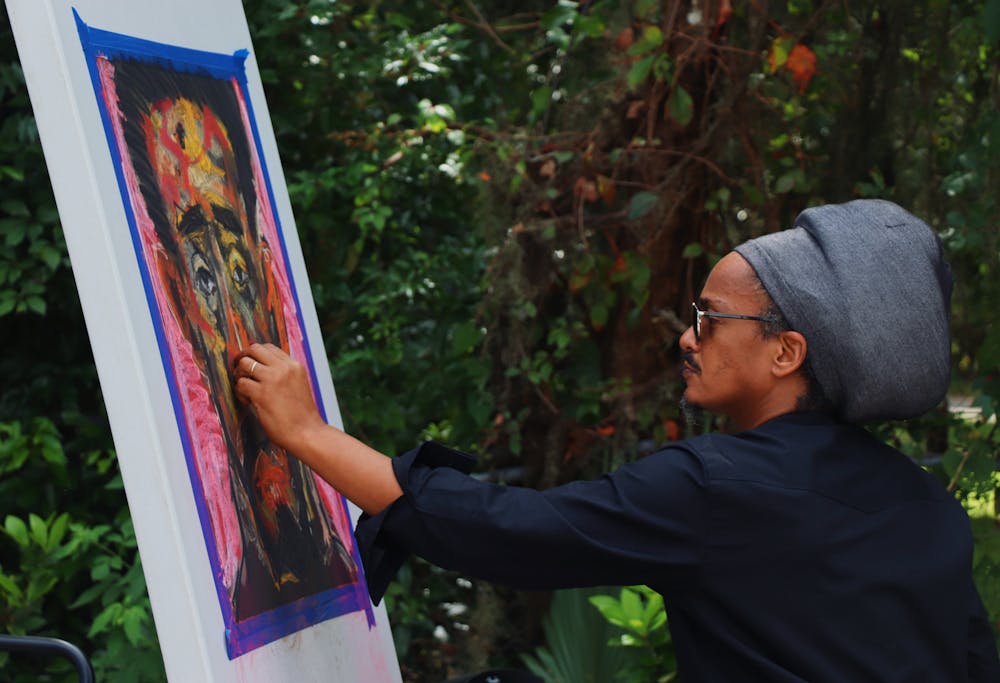A collection of Ethiopian artist Prince Merid Tafesse’s work was presented at the A. Quinn Jones Museum & Cultural Center Sept. 25.
The museum, located at 1013 NW Seventh Ave., hosted the 47-year-old’s exhibition, “Living and Linking: African Legacies.”
Tafesse’s artistic journey began several decades ago, when he decided to try his hand with art as a young child in Ethiopia. Following the spark from his mother, an amateur artist, he began his venture into the artistic universe drawing a portrait of an Ethiopian Atse, an Emperor.
Tafesse’s recalls watching his mother attempt a drawing of the Ethiopian Emperor Tewodros II, who killed himself after an onslaught by the British in the 19th century. On the back of the paper his mother was using, the young Tafesse tried to mimic his mother’s work and included a macabre detail: a drawing of a gun to indicate the emperor’s suicide. Tafesse remembers misidentifying the leader and instead writing Menelik, another Ethiopian leader.
Tafesse laughs softly as he recalls the episode from his childhood. On Saturday, Tafesse completed a live sketch of Haile Selassie, a former Ethiopian emperor, in approximately 10 minutes.
The purpose of Tafesse’s exhibition was to showcase connections across continents and undermine the narrative of a fundamental divergence of cultures. The exhibition aims to show how art from the continent of Africa can speak to universal aspects of the human condition and should not be marginalized.
The goal is to raise a sense of consciousness and curiosity, said Desta Meghoo, Tafesse’s wife and an artistic curator.
“When we think of African art, we get certain images,” she said. “But, in my theory as a curator, I always say we don’t call Picasso’s art Spanish art. We’re talking about a contemporary style artist [Tafesse] who is connected to the world, whose visual vocabulary is one that transcends nationality, gender, etc and his art speaks to that.”
One of the links Meghoo said she was most compelled by was the connection she found between the legacies of A. Quinn Jones, the museum’s namesake, and Haile Selassie. The two held firm commitments to education.
Tafesse’s artistic inspirations range from writers, such as Kahlil Gibran and Oscar Wilde, to musical inspirations such as Bob Marley and trap music, Meghoo said.
One piece included in the exhibition served as Tafesse’s recounting of COVID-19’s effects on Ethiopia. The piece features tick marks used to indicate the passage of days; after the murder of George Floyd, the tick marks were converted into matches to represent the emergence of social unrest as a result of his death.
Tefesse’s family legacy is important to him. He traces his ancestry to the Ethiopian king Sahle Selassie through his mother. He said his father informed him of his regal heritage when he was younger but did not give him specifics. Tafesse said his father used to refer to his mother by the term Le’elt, which means princess, in acknowledgement of her heritage.
“My father told me you’re from the royal family, but when you grow up, when you’re ready, find it,” Tafesse said. “He didn’t want to show me exactly.”
In recent years, Tafesse was able to identify his mother’s place in the family tree and discover his exact standing in the regal line.
Tafesse said he may go months at a time without producing artistic works until he feels ready to start creating.
“I just don’t work physically and gather things wherever I go. I don’t know what I gather even; it’s almost subconscious,” Tafesse said.
Some of Tafesse’s works were also displayed at the Rosa B. Williams Center on 524 NW First St.
Contact Omar Ateyah at oateyah@alligator.org. Follow him on Twitter @OAteyah.

Omar Ateyah is a third-year journalism student and the Alligator's Race and Equity reporter. He previously served as the Alligator's crime reporter and as a news assistant on the Metro Desk. He enjoys going on long, thoughtful walks.






